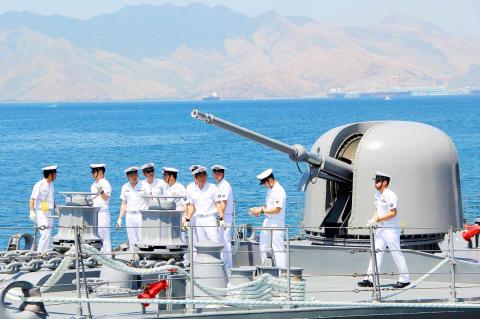Two Japanese destroyers and a submarine yesterday docked at a port in the Philippines near disputed South China Sea waters, where Beijing’s increasingly assertive behavior has sparked global concern.
Manila is seeking to improve ties with Tokyo as tensions mount over the disputed waterway, almost all of which is claimed by China.
Japanese submarine Oyashio and destroyers JS Ariake and JS Setogiri docked at Subic Port for a routine visit at a sprawling former US naval base just 200km from a Chinese-held shoal.

Photo: EPA
“The visit is a manifestation of a sustained promotion of regional peace and stability and enhancement of maritime cooperation between neighboring navies,” Philippine Navy spokesman Commander Lued Lincuna said.
The Ariake was equipped with an anti-submarine helicopter, according to a photographer at the scene.
The port call came on the eve of war games between the US and Filipino soldiers in the Philippines, which is seen as a showcase of a long-standing military alliance that Manila is counting on to deter China.
Seriously outgunned by its much larger rival China, the Philippines has turned to allies like the US and Japan to upgrade its armed forces in recent years.
In February, Japan agreed to supply the Philippines with military hardware, which might include anti-submarine reconnaissance aircraft and radar technology.
Tensions in the South China Sea — through which one-third of the world’s oil passes — have mounted in recent months since China transformed contested reefs into artificial islands capable of supporting military facilities.
Aside from the Philippines, Taiwan, Vietnam, Brunei and Malaysia also have overlapping claims.
Japan and China are locked in a separate dispute over an uninhabited island chain in the East China Sea.
The Philippines has asked a UN-backed tribunal to declare China’s sea claims as illegal and the government expects a decision this year.

LONG FLIGHT: The jets would be flown by US pilots, with Taiwanese copilots in the two-seat F-16D variant to help familiarize them with the aircraft, the source said The US is expected to fly 10 Lockheed Martin F-16C/D Block 70/72 jets to Taiwan over the coming months to fulfill a long-awaited order of 66 aircraft, a defense official said yesterday. Word that the first batch of the jets would be delivered soon was welcome news to Taiwan, which has become concerned about delays in the delivery of US arms amid rising military tensions with China. Speaking on condition of anonymity, the official said the initial tranche of the nation’s F-16s are rolling off assembly lines in the US and would be flown under their own power to Taiwan by way

OBJECTS AT SEA: Satellites with synthetic-aperture radar could aid in the detection of small Chinese boats attempting to illegally enter Taiwan, the space agency head said Taiwan aims to send the nation’s first low Earth orbit (LEO) satellite into space in 2027, while the first Formosat-8 and Formosat-9 spacecraft are to be launched in October and 2028 respectively, the National Science and Technology Council said yesterday. The council laid out its space development plan in a report reviewed by members of the legislature’s Education and Culture Committee. Six LEO satellites would be produced in the initial phase, with the first one, the B5G-1A, scheduled to be launched in 2027, the council said in the report. Regarding the second satellite, the B5G-1B, the government plans to work with private contractors

MISSION: The Indo-Pacific region is ‘the priority theater,’ where the task of deterrence extends across the entire region, including Taiwan, the US Pacific Fleet commander said The US Navy’s “mission of deterrence” in the Indo-Pacific theater applies to Taiwan, Pacific Fleet Commander Admiral Stephen Koehler told the South China Sea Conference on Tuesday. The conference, organized by the Center for Strategic and International Studies (CSIS), is an international platform for senior officials and experts from countries with security interests in the region. “The Pacific Fleet’s mission is to deter aggression across the Western Pacific, together with our allies and partners, and to prevail in combat if necessary, Koehler said in the event’s keynote speech. “That mission of deterrence applies regionwide — including the South China Sea and Taiwan,” he

‘NARWHAL’: The indigenous submarine completed its harbor acceptance test recently and is now under heavy guard as it undergoes tests in open waters, a source said The Hai Kun (海鯤), the nation’s first indigenous defense submarine, yesterday began sea trials, sailing out of the Port of Kaohsiung, a military source said. Also known as the “Narwhal,” the vessel departed from CSBC Corp, Taiwan’s (台灣國際造船) shipyard at about 8am, where it had been docked. More than 10 technicians and military personnel were on deck, with several others standing atop the sail. After recently completing its harbor acceptance test, the vessel has started a series of sea-based trials, including tests of its propulsion and navigational systems, while partially surfaced, the source said. The Hai Kun underwent tests in the port from